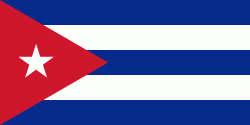Villa Clara Province (Provincia de Villa Clara)
Prior to 1976, the current provinces of Cienfuegos, Sancti Spíritus, and Villa Clara were all part of the now obsolete province of Las Villas, but Villa Clara is still referred some times just as "Las Villas" using the shorter old name. Santa Clara was the capital of historical Las Villas and still capital of Villa Clara province. That old name itself, Spanish for "The Cities", refers to the four original 16th and 17th-century cities founded in this vast territory: San Juan de los Remedios, Sancti Spíritus, Santísima Trinidad and Gloriosa Santa Clara.
During pre-Spanish settlement in Cuba, what now is Villa Clara province was populated by Taíno people with chieftains of Sabanaque (north west), Sabana (north east), and Cubanacan, literally "The Middle Land" in the center where Santa Clara city is located nowadays. In this region from the eastern landing point of the Spanish was where Columbus believed the "King of India" was living. In early colonial Cuba, historical province Las Villas was center to cattle industry but by the 18th and 19th centuries it had shifted to sugar production with a large concentration of mills. At the beginning of the 20th century it had the highest percentage of land farms (90%). In 1950 it was second to Havana in manufacturing establishments.
After Castro's revolution in the 1960s it still led in sugar production on the island, but in the late 80s and 90s after the collapse of the Soviet Union and lack of support thereof, most of the already inefficient mills were closed down, some of them disassembled, while others became museums. Only the most efficient mills are still producing sugar. Since then the province concentrated its efforts on building beach resorts.
The country's first transgender municipal delegate was elected in Villa Clara in early 2013. Adela Agustin Hernandez is a resident of the town of Caibarien and works as a nurse electrocardiogram specialist.
Map - Villa Clara Province (Provincia de Villa Clara)
Map
Country - Cuba
 |
 |
| Flag of Cuba | |
The territory that is now Cuba was inhabited by the Ciboney people from the 4th millennium BC with the Guanahatabey and Taíno peoples until Spanish colonization in the 15th century. From the 15th century, it was a colony of Spain, and slavery was abolished in 1886, remaining a Spanish colony until the Spanish–American War of 1898, when Cuba was occupied by the United States and gained independence in 1902. In 1940, Cuba implemented a new constitution, but mounting political unrest culminated in a coup in 1952 and the subsequent dictatorship of Fulgencio Batista, which was later overthrown in January 1959 by the 26th of July Movement during the Cuban Revolution, which afterwards established communist rule under the leadership of Fidel Castro. The country was a point of contention during the Cold War between the Soviet Union and the United States, and a nuclear war nearly broke out during the Cuban Missile Crisis of 1962. Following the collapse of the Soviet Union, Cuba faced a severe economic downturn in the 1990s, known as the Special Period. In 2008, Fidel Castro resigned after 49 years of leadership of Cuba and was replaced by his brother Raúl Castro.
Currency / Language
| ISO | Currency | Symbol | Significant figures |
|---|---|---|---|
| CUC | Cuban convertible peso | $ | 2 |
| CUP | Cuban peso | $ | 2 |
| ISO | Language |
|---|---|
| ES | Spanish language |





















